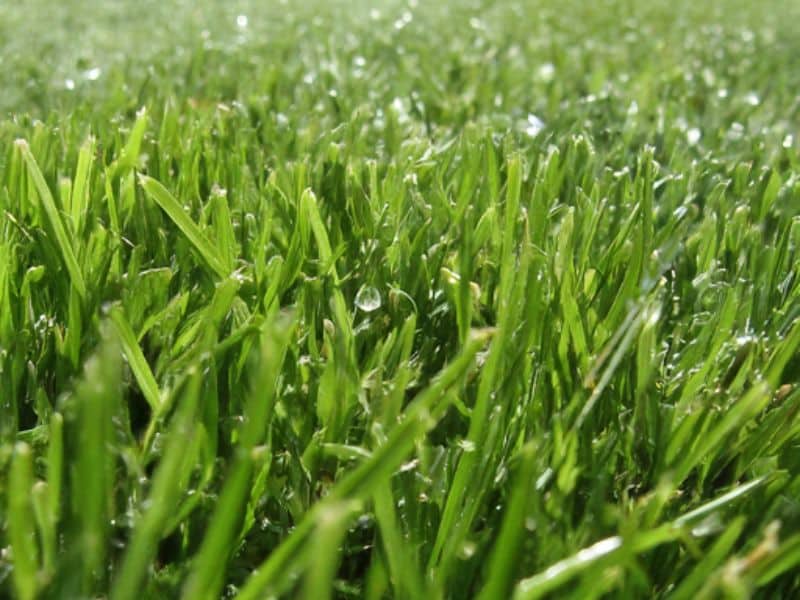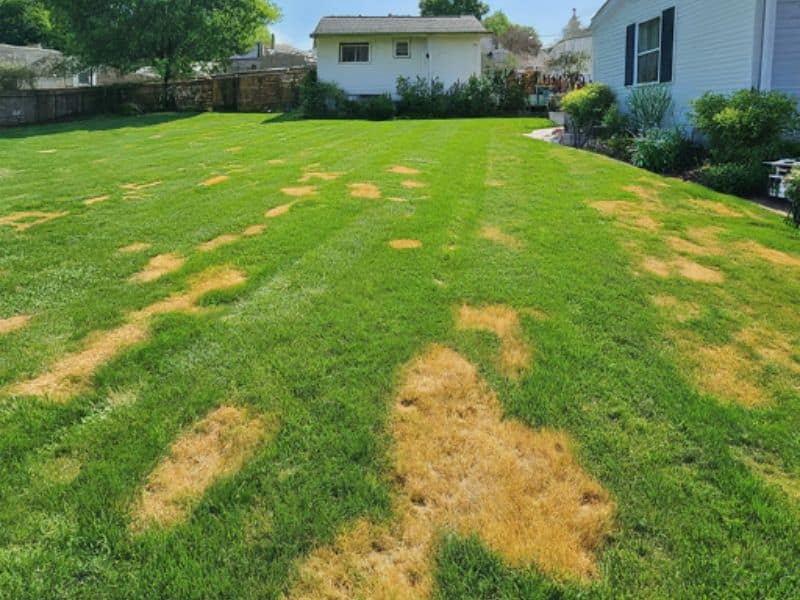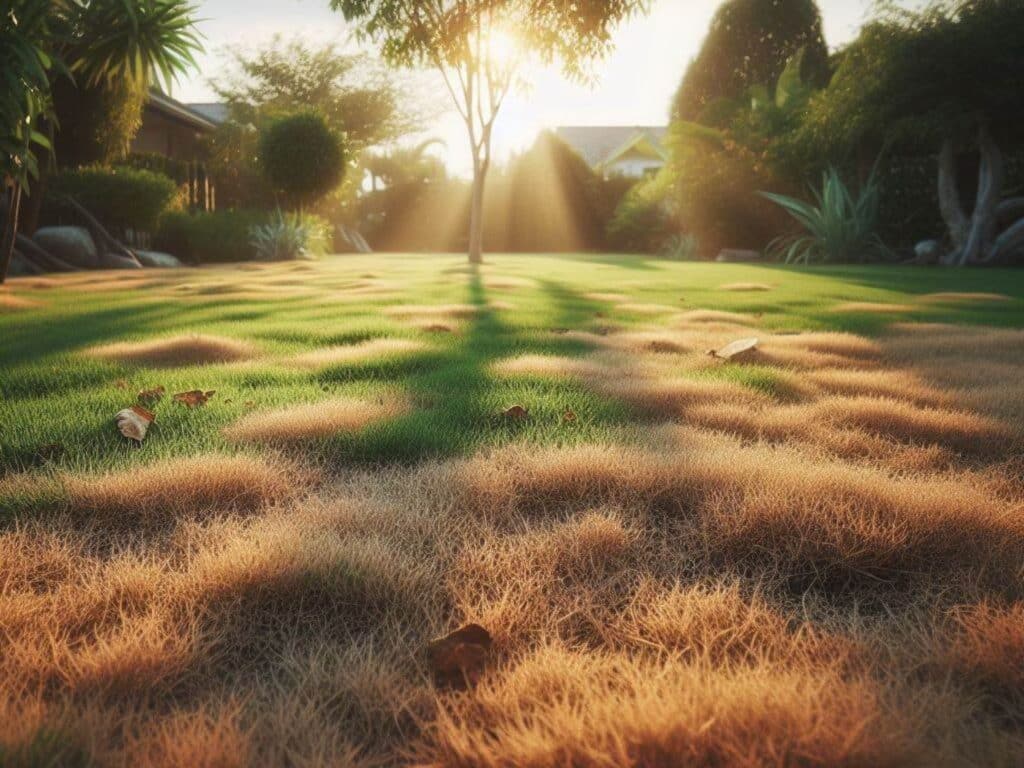Maintaining the perfect lawn is more art than science, balancing on the thin line between too much and too little. You’ve noticed your grass isn’t looking its best, but the culprit behind those lackluster patches can be elusive.
Is it drowning in excess love, or thirsting for more attention? Understanding the difference between overwatered and under-watered grass is crucial, not just for your lawn’s aesthetic, but for its health and your water bill.
Recognizing the signs of distress caused by improper watering can save you from the heartache of a dying lawn. This article will guide you through identifying whether your grass is gasping for air or parched for water.
You’ll learn the symptoms to watch for, the causes behind them, and most importantly, how to strike the perfect hydration balance. Let’s dive into turning your lawn into the lush, verdant oasis it’s meant to be.
Understanding the Basics of Lawn Watering
Having a green, vibrant lawn is a symbol of pride for many homeowners. But getting that lush greenery isn’t as simple as watering your grass whenever you remember. It’s a delicate balance that requires attention to detail.
Following on from the importance of recognizing signs of distress in your lawn, let’s dive deeper into how to maintain that perfect hydration level without overdoing it or providing too little.
Signs of Overwatering Your Grass

First off, if you’re stepping on your lawn and it feels squishy like a wet sponge, that’s a clear sign you may well be loving it a bit too much with your hose. This sogginess can smother your grass roots and even invite some unwelcomed fungi guests.
Also, keep an eye out for blades of grass that are wilting or appearing a bit too yellow – it’s not sunbathing; it’s actually a distress signal. Overwatered grass doesn’t just look unattractive; it’s basically sending out SOS signals begging for a breather.
The Impact on Grass Health
Consequences of Overwatering
Overwatering your lawn goes beyond just a soggy garden; it actively harms your grass’s health. Roots suffocate because they can’t breathe underwater – yes, roots do need to breathe!
This lack of oxygen in the root zone can lead to root rot, a condition as grim as it sounds. Additionally, fungal diseases thrive in moist conditions. If your lawn’s got more mushrooms than a gourmet kitchen, you’ve likely been a bit too generous with the hose.
Consequences of Underwatering
On the flip side, underwatering isn’t doing your lawn any favors either. Grass blades become brittle, changing from a vibrant green to a dull, lifeless brown when they’re thirsty. This is your lawn crying out for hydration.
Furthermore, parched roots can’t tap into the nutrients soil has to offer since water acts as a conduit for nutrient uptake. Think of it as trying to eat dinner without any utensils – it’s possible, but it’s a lot harder and messier.
Ideal Watering Practices for Healthy Grass
Determining Your Lawn’s Water Needs
To figure out how much water your grass really needs, start by getting to know your soil. Sandier soils drain quickly, so they require more frequent watering. In contrast, clay soils hold water longer, meaning less frequent watering works best.
Aim for an inch of water per week, either from rainfall or your hose, ensuring your lawn gets enough moisture to reach deep roots without causing excess that leads to the problems discussed earlier.
Best Times and Techniques for Watering
Watering your lawn at the right time can make a huge difference. Early morning is your best bet as it allows water to seep into the soil before the sun can evaporate it, ensuring deep root absorption.
Avoid watering in the evening; this can leave your lawn damp overnight, increasing the risk of fungal diseases. Use a sprinkler that distributes water evenly, and think about investing in a rain gauge to keep track of how much water your lawn is getting from rainfall. This approach helps avoid the pitfalls of both over and underwatering, promoting a lush, green lawn.
Troubleshooting Common Watering Mistakes
Adjusting Your Watering Schedule
Adjusting your watering schedule is crucial to avoid over or underwatering your grass. Depending on the season, your lawn’s hydration needs can change significantly.
During hotter months, your lawn may well need more frequent watering to combat the intense heat that dries out the soil quicker. Conversely, in cooler months, watering needs decrease as evaporation rates fall and your grass doesn’t grow as fast.
A smart move is to invest in a programmable sprinkler system that adapts to these changes automatically, ensuring your lawn gets just the right amount of water all year round. Remember, overdoing it can lead to as many problems as not watering enough, so keep a keen eye on weather patterns and adjust accordingly.
Recognizing the Need for Lawn Aeration
If your lawn care efforts are on point but your grass still seems unhappy, it may well be time to think about aeration. Compacted soil prevents water, nutrients, and air from reaching grass roots effectively, which can hinder growth and make your lawn more susceptible to both drowning and drought.
Telltale signs your lawn is begging for aeration include water pooling on the surface after watering and a spongy feeling underfoot.
Aeration involves perforating the soil with small holes to allow air, water, and nutrients to penetrate the grass roots. This process can help your lawn breathe better, absorb water more efficiently, and thus bounce back to its green glory.
Advanced Tips for Balanced Lawn Hydration

Utilizing Technology for Efficient Watering
In today’s tech-savvy era, leveraging technology for lawn care can make a big difference in maintaining the perfect balance of moisture for your grass. Smart sprinkler systems are a game-changer.
They come equipped with sensors that detect moisture levels in the soil, adjusting the watering schedule automatically to prevent over or under-watering. Think of them as your personal lawn care assistant that works 24/7 to keep your lawn in tip-top shape, without you having to lift a finger.
Additionally, investing in a rainfall detector can save your lawn from extra water it doesn’t need after a heavy rain, cutting down on water waste and ensuring your grass gets just what it needs.
Adapting to Weather Changes and Seasons
As the seasons shift, so should your lawn watering strategy. Summer demands more frequent watering sessions to combat the intense heat, while spring may require less due to natural rainfall.
It’s critical to stay ahead of the weather forecast, adjusting your watering plan accordingly. In hot, dry periods, morning watering reduces evaporation, ensuring water reaches the roots where it’s needed most.
Conversely, during cooler months, reducing the watering frequency helps protect your lawn from becoming waterlogged, which can lead to fungal diseases. Remember, it’s not just about sticking to a schedule; it’s about adapting to give your grass exactly what it needs to thrive, no matter the season.
Up next:







